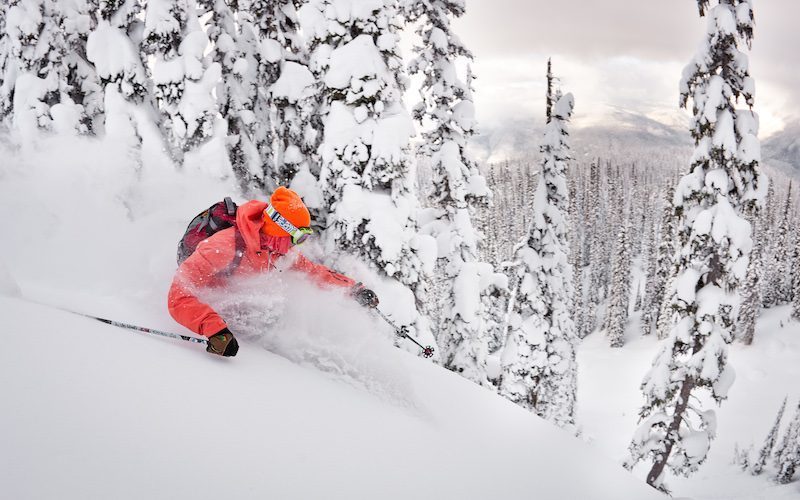Snow is, of course, the vital component of a ski or snowboarding holiday. Resorts spend hundreds of millions of euros and dollars each year in snowmaking systems to ensure, they hope, they have enough, and we drool over ski movies that invariably show pros bouncing effortlessly through waist deep powder. It seems we can’t get enough of the white stuff.
And yet … can you have too much of a good thing? When it snows and snows, then you may have difficulty actually getting to the ski slopes, and (less of a big deal) getting home. The lifts and runs may be closed for avalanche risk, and you can do nothing but hole yourself up in the nearest mountain restaurant, and stretch après-ski out from dawn until the small hours (nightmare …!).
No, what we really want is a huge fall the day before we arrive, then the sun to come out and blue skies above for our perfect powder holiday.
In fact some of us, although we don’t like to admit it, are even happier if the piste bashers have had the chance to groom the slopes into shape, so we don’t have to work up a sweat freeriding, giving us groomed carving slopes every time.
And there’s also the question of what is perfect powder? The quality of snow varies a lot you see. The driest, fluffiest powder tends to be found some way inland in North America, in states like Colorado and Utah, which have trademarked terms like “The greatest snow on Earth”, and further north in British Columbia, Canada, as well as on Hokkaido, Japan’s northerly island. In both of these latter cases the air has been toasted dry over plains stretching for thousands of kilometres, before it hits the mountains and is forced to rise, depositing precipitation in abundance.
So there’s a question of quality as much as quantity. Some areas get lots of snow, but not lots of great snow.
And as a final proviso, it has to be noted that average snowfall figures are forever changing, and are generally published by resort marketing departments. So if they have a good season, that one season will be measured and put out as the area stat, but if they have a good season then four bad ones, they’ll add the past five together to reach the one good one to include in their ”5-year average”.
But all that being said and understood, here we go with what are (probably) the world’s ten snowiest ski resorts.
1. Mt Baker, Washington State, USA – 16.3m
Mt Baker not only holds the average annual snowfall record, but the ski area is also home to the world record for the greatest recorded snowfall in one season, 29m, recorded during the winter of 1998–99.
2. Alyeska, Alaska, USA, 16.25m
Alyeska, located around 48km from Alaska’s capital Anchorage, has been in British tour operator brochures in years gone by, but you need to make your own way there now. You’d be best to book a 4×4 rental cat though, given that more than 15m of snow falls on average each season; and around 24m was recorded for their 2011–12 season.
3. and 4. Alta and Snowbird, Utah, USA – 15.6m
Snowbird is accurately named, and for its powder skiing famed, with one of the longest seasons in the US, right through to the end of May and sometimes longer, thanks to the abundance of exceptionally light powder. Alta – to which it is linked – is famed for its steep and deep terrain.
5. Niseko, Japan – 15.1m
What’s interesting when you look at a world map is that most of the world’s snowiest resorts, and indeed most of the major northern hemisphere ski areas, are located in a fairly narrow band approximately 42–48° above the Equator. Many of the resorts in the Alps and the Rockies are there, so is Mt Washington and Niseko. The powder here is world-famous for is quality, as well as its abundance.
6. Revelstoke, BC, Canada – 15m
Canada’s highest entry is one of the world’s newest resorts. As such it has not had long to build-up a reliable average annual snowfall figure, but the early signs are good.
7. Nozawa Onsen, Japan – 14.44m
This is another Japanese area famous for its abundant snowfall (one of many in fact), and where monkeys famously bathe in natural hot springs. You can’t blame them considering!
8. Gulmarg, India – 14m
It’s difficult to get any official snowfall stats from Gulmarg, but 14m is the consensus, and the resort is certainly famous for its spectacular snowfalls and deep powder.
9. Kirkwood, California, USA – 13.95m
California’s snowiest entry has one of the state’s best reputations, and is now part of the Vail Resorts empire.
10. It’s A Draw, USA – 12.7m
A collection of five western US ski areas all, remarkably, claim the same 12.7m average base depth. They include Mt Brighton, Powder Mountain and Solitude in Utah, Sugar Bowl in California, and in Wyoming, Grand Targhee.


